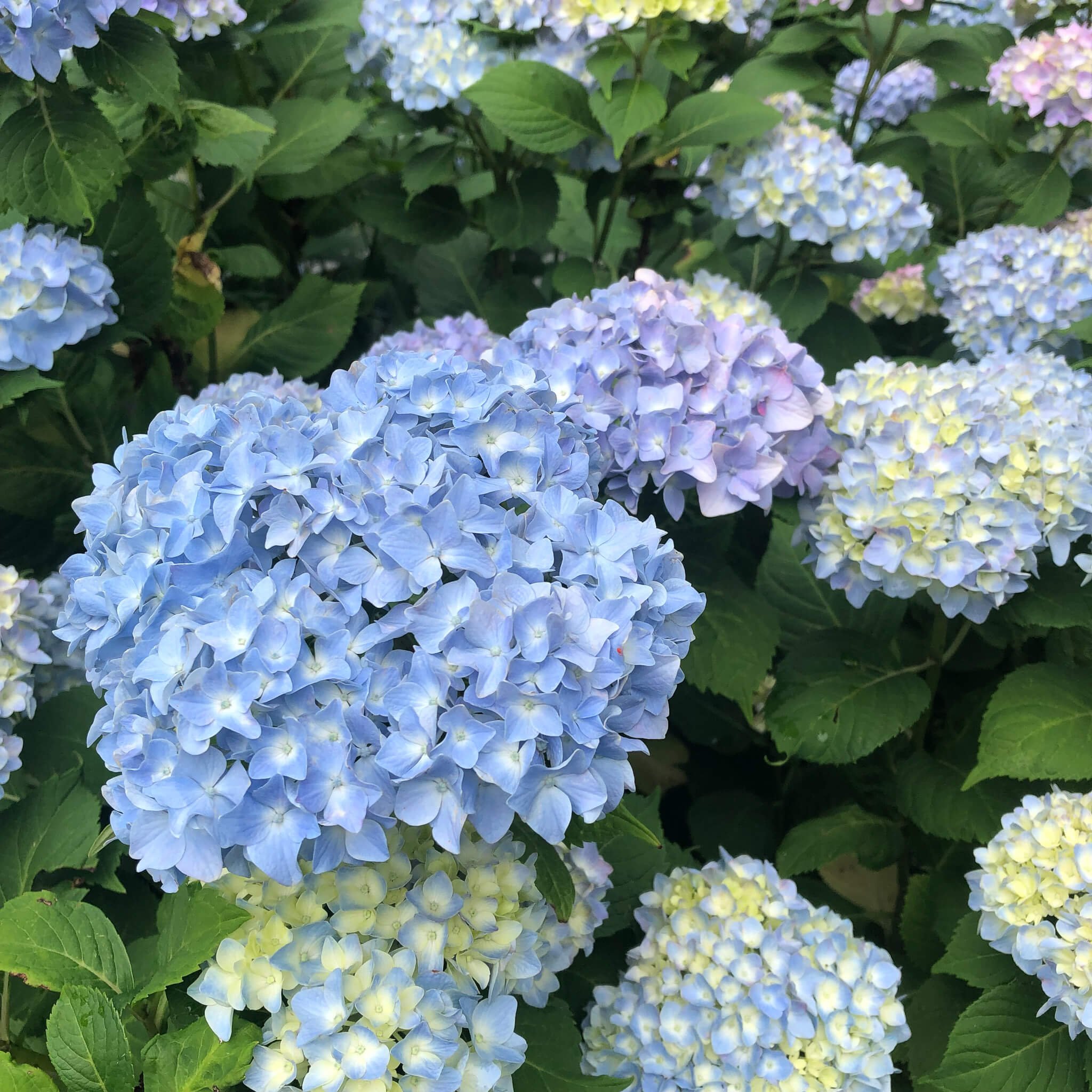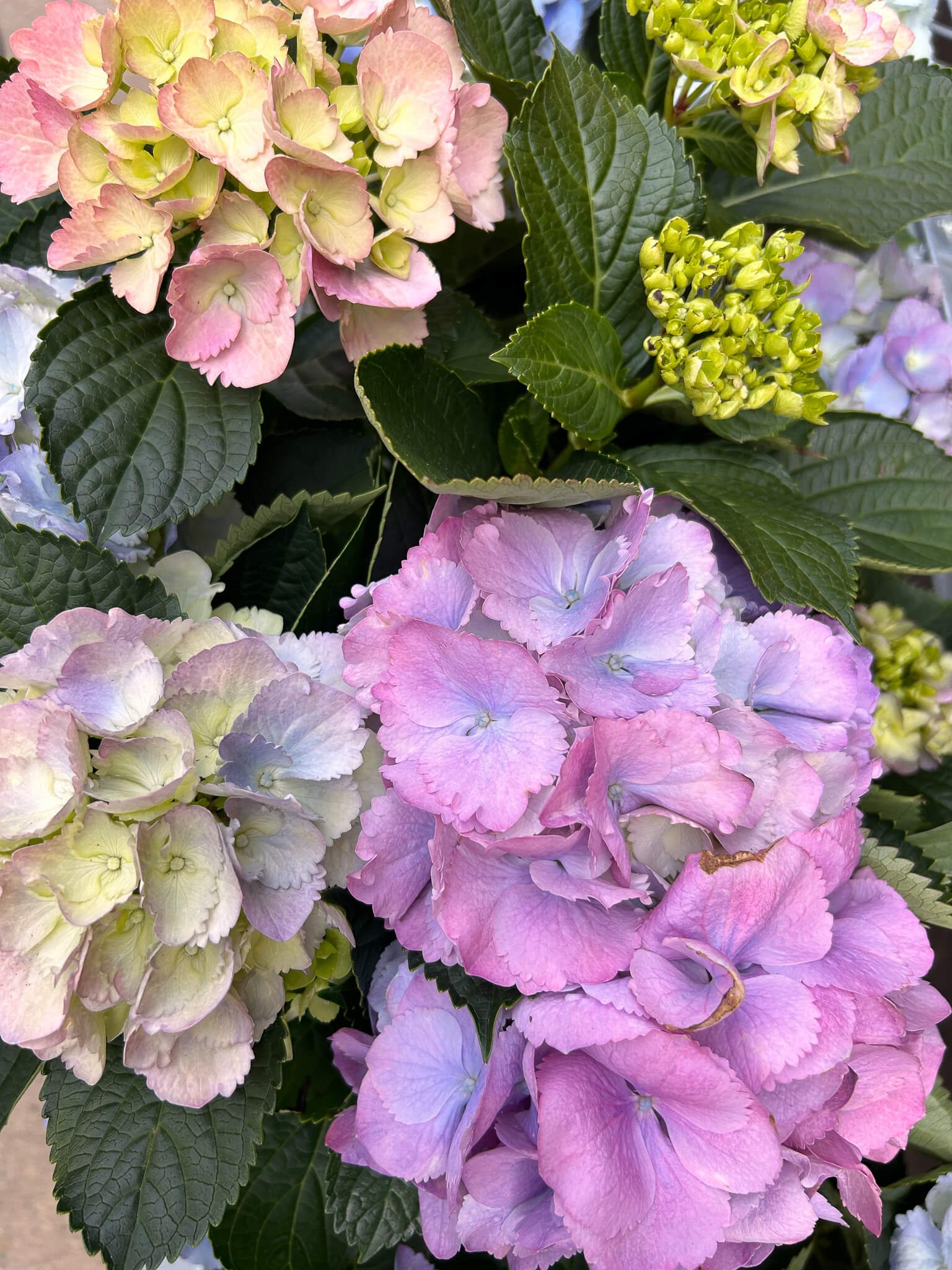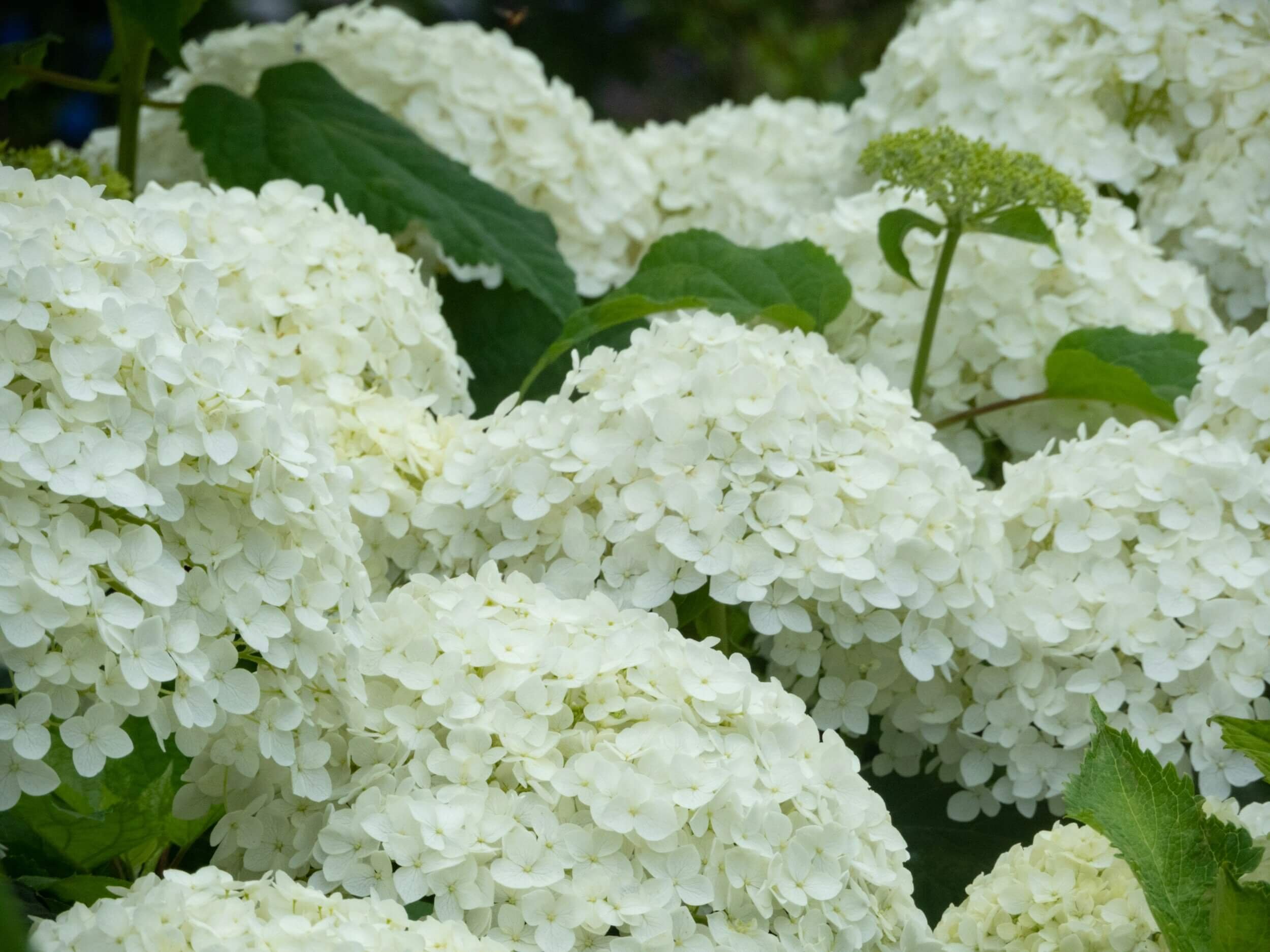First Editions® Eclipse® Bigleaf Hydrangea
Cover Image Courtesy of Bailey Nurseries
Bring drama to your garden and landscape with dark foliage and mophead blooms!
The Eclipse® hydrangea (Hydrangea macrophylla ‘Bailmacseven’) is a cultivar of the bigleaf hydrangea, a deciduous shrub native to Japan and China belonging to the Hydrangeaceae family.
This unique hydrangea selection has deep purple leaves that remain dark all summer long, even in warm and sunny climates.
The mophead flowers bloom throughout the summer and have cream-colored petals edged with shades of cranberry or dark purple, depending on the soil pH.
Flowers deepen in color as the season progresses, eventually drying and turning brown in autumn. Dried flower heads bring winter interest to the garden.
Eclipse® hydrangeas grow in zones 5 - 9, and prefer partial shade and rich, well-draining soil. This hydrangea with dark leaves also has improved resistance to fungal diseases.
Deer will eat hydrangea flower buds and leaves, especially the tender young growth.
If you would like to grow a flowering shrub that deer tend to leave alone, try Ruby Spice summersweet clethra as a deer resistant alternative to the bigleaf hydrangea.
Read on to discover how to grow and care for this dark-leaved hydrangea, and get landscaping and companion planting ideas.
The dark foliage and mophead flowers of the First Editions® Eclipse® Bigleaf Hydrangea. Image courtesy of Bailey Nurseries.
Does the Eclipse® Bigleaf Hydrangea Bloom on Old or New Wood?
The Eclipse® hydrangea blooms on old wood. Flower buds for the summer season have developed on the previous year's growth.
This shrub generally does not need pruning, but if you must prune your Eclipse® hydrangea, it should be done after it has finished blooming for the year and before the next season's buds begin to form.
Pruning too late can risk removing the buds, potentially affecting the plant's blooming performance for the following season. To put this in context of the seasonal gardening calendar:
Spring - buds have been set the previous year, so don’t prune! However, you may remove and clean out old, dead, or weak stems. You can tell which stems are dead by scratching away at the surface of each stem. If you see green, it’s a living stem and you should be left alone. If you see brown, the stem is dead and can be safely pruned away.
Summer - the shrub is flowering, enjoy the show! When flowering has finished, you have a small window of time to prune the shrub, if needed, before late summer. Flower buds develop starting in late summer to early fall. Complete your pruning prior to late summer.
Fall - buds are forming for next spring’s flowering show - don’t prune! You do not need to prune back Eclipse® hydrangeas in the fall.
Winter - buds are set for the springtime - don’t prune!
How to Plant and Grow the Eclipse® Bigleaf Hydrangea
Planting: The best time of year to plant an Eclipse® hydrangea is in the spring or fall, giving the roots time to establish before the onset of extreme hot or cold weather. Water deeply immediately after planting.
Location: Choose a location with well-drained soil that is rich in organic matter. Eclipse® hydrangeas prefer soil that retains moisture but does not become waterlogged. Select a spot with partial shade and protection from the intense afternoon sun.
Soil: Amend the soil with organic matter, such as compost, shredded leaves, or Leaf-gro® to improve drainage and soil fertility. If you would like your Eclipse® hydrangea to bloom a more vibrant cranberry red, consider getting a soil test and adding lime to the soil. Add sulfur for deeper purple flower coloration.
Mulch: Apply a layer of organic mulch around the base of the plant to retain soil moisture, regulate temperature, and suppress weeds. Make sure the mulch does not touch the base of the plant.
Watering: Keep the soil consistently moist but not waterlogged, especially during periods of drought. Deep watering is preferable to encourage the development of a strong root system (Are you in a drought? Check the U.S. Drought Monitor).
Fertilization: Hydrangeas typically do not need fertilization when they are given the rich, fertile soil they prefer. Each spring, spread a layer of compost, shredded leaves or Leaf-gro® around the base of your hydrangea, being careful to keep away from the base of the shrub.
Pruning: Eclipse® hydrangeas grow buds in late summer and fall on old wood - consequently, pruning should be done in early to mid-summer, immediately after flowering. No more than 1/3 of the plant should be cut back.
Pest and Diseases: Anthracnose and cottony camellia scale can be occasional problems. Ensure good air circulation around your plants to minimize the risk of disease, and practice good watering habits (see “How to Water your Plants” to brush up on your watering skills).
The First Editions® Eclipse® Bigleaf Hydrangea prefers morning sun and afternoon shade.
What’s Wrong with My Eclipse® Hydrangea?
Eclipse® hydrangea buds, like those of many hydrangea varieties, can be susceptible to damage from extreme weather conditions. Frost damage to a hydrangea can range from minor to severe, and can look like shriveled brown or black leaves and buds and drooping, wilting flower heads.
Late Spring Frosts: One of the primary risks is exposure to late spring frosts. Eclipse® hydrangea buds are formed on old wood, and if a late frost occurs after the buds have emerged, it can damage or kill them, leading to either reduced or no flowering for the rest of the summer.
Freezing Temperatures: Extremely low temperatures, especially in winter or early spring, can also damage the buds. Prolonged exposure to freezing temperatures can cause the buds to freeze and become more susceptible to damage.
Unseasonal Temperature Fluctuations: Drastic fluctuations in temperatures during the bud development stage can be harmful. Warm periods followed by sudden cold snaps can disrupt the normal development of buds, potentially leading to bud damage.
In regions where late spring frosts are common, like the Northern and Mid-Atlantic states, Eclipse® hydrangeas are more susceptible to frost damage, resulting in reduced or no flowering for an entire season. If you are worried about this potential for frost damage, consider growing a reblooming hydrangea cultivar like the Endless Summer® Pop Star® Reblooming Hydrangea.
Do Eclipse® Bigleaf Hydrangeas Like Sun or Shade?
Ecllpse® hydrangeas thrive in partial shade and do best when they receive 2-4 hours of sunlight per day.
While they can tolerate more sun, Eclipse® hydrangeas prefer dappled or filtered light, with protection from the intense hot afternoon sun.
In hot climates, providing them with morning sun and afternoon shade can help prevent their flowers and leaves from wilting and scorching.
In cooler regions, they may tolerate more sun, but protection from harsh afternoon sunlight is still recommended.
Planting Companions for Eclipse® Bigleaf Hydrangeas
Feeling inspired to plant an Eclipse® hydrangea in your garden? Here are some ideas for planting companions - all favor the same partial shade conditions and moist, rich, well-draining soil that bigleaf hydrangeas love.
Japanese Painted Fern (Athyrium niponicum): A low-growing, soft fern with purple-streaked silvery foliage complements the dark color scheme of the Eclipse® hydrangea.
Gem Box Inkberry Holly (Ilex glabra 'SMNIGAB17'): This compact, globe-shaped evergreen creates a pleasing contrast of color and texture when planted alongside the Eclipse® hydrangea.
Jack of Diamonds Brunnera (Brunnera macrophylla ‘Jack of Diamonds’): A Brunnera with huge, heart-shaped leaves and dainty blue spring flowers. The Eclipse hydrangea highlights the dramatic dark veining pattern on the silver leaves of this Brunnera cultivar.
Little Missy Boxwood (Buxus microphylla ‘Little Missy’): A row of these petite, 24-inch high compact evergreens can be planted in front of a row of Eclipse® hydrangeas, creating a contrast of structure and form.
Silver Gumdrop Coral Bells (Heuchera ‘Silver Gumdrop’ Dolce®): A heuchera hybrid with iridescent, semi-gloss silvery leaves that take on tones of blush pink. Vibrant pink flowers emerge in late spring and pair nicely with the Eclipse® hydrangea.
NewGen Independence® Boxwood (Buxus NewGen Independence® ‘SB 108’): The small evergreen leaves and structured shape of boxwoods are the perfect foil for the larger, deep purple leaves and loose form of the Eclipse hydrangea. NewGen Independence® has a rounded habit and improved resistance to boxwood leafminer.
Glamour Girl Tall Garden Phlox (Phlox paniculata ‘Glamour Girl’): A tall perennial with green leaves and panicle-shaped flowers. The hot coral pink blooms complement the Eclipse hydrangea all summer long.
Cavatine Japanese Andromeda (Pieris japonica ‘Cavatine’): Striking evergreen leaves and delicate, bell-shaped white flowers contrast nicely with the large toothed leaves of the Eclipse® hydrangea.
Delaware Valley White Azalea (Rhododendron ‘Delaware Valley White’): The white flowers and dark green foliage of this evergreen azalea won’t clash with the dark leaves and cranberry-tinged flowers of the Eclipse® hydrangea.
Astilbe (Astilbe species): The fine textured foliage and spiky summer flowers of astilbe are the perfect partner for the large, serrated leaves of the Eclipse® hydrangea. Scarlet red varieties like ‘Red Sentinel’ look particularly nice.
The First Editions® Bigleaf Hydrangea shines in a border garden planting. Image courtesy of Bailey Nurseries.
Landscaping Ideas for Eclipse® Bigleaf Hydrangeas
Specimen Planting: The dramatic dark leaves and bright flowers of the Eclipse® hydrangea make it the perfect stand-alone specimen to bring drama and attention to your yard.
Foundation Planting: Plant Eclipse® hydrangeas along the foundation of your home. Their dramatic dark purple foliage and colorful blooms will enhance the curb appeal of your home. The deep-purple leaves and cranberry red blossoms look particularly striking against the backdrop of a house painted in lighter tones of warm gray.
Mixed Borders: Create a mixed border planting by combining Eclipse® hydrangeas with other complementary plants. Consider pairing with bulbs, perennials, ornamental grasses, and evergreen shrubs for four seasons of visual appeal.
Woodland Garden: The dappled shade underneath the canopy of tall trees is an ideal spot for an Eclipse® hydrangea. Combine with other partial-shade loving plants like camellias, Japanese andromeda, azaleas, and rhododendrons.
Accent Planting: Use Eclipse® hydrangeas to create a focal point in the landscape. Plant strategically to draw attention to specific areas of the garden, like entryways, water features, pathways, or seating areas.
Vintage Cottage Garden: For a charming, informal, cottagecore look, plant an Eclipse® hydrangea alongside old-fashioned cottage garden favorites like foxgloves, garden phlox, hollyhocks, catmint, hibiscus, and roses.
Goth Garden: Embrace the newest garden trend by planting an Eclipse® hydrangea alongside other plants with dark foliage. The dark purple leaves of this hydrangea make it the perfect plant choice for incorporating into a romantic, mysterious, eerie Goth garden.
How to Change the Color of an Eclipse® Bigleaf Hydrangea
You can change the color of your bigleaf hydrangea blooms by manipulating the pH of the soil. The pH level affects the availability of aluminum in the soil, in turn influencing the color of hydrangea flowers.
Adding aluminum sulfate, garden sulfur, or organic matter makes the soil more acidic and will turn the edges of Eclipse® hydrangea flowers a more intense dark purple.
Adding garden lime raises the soil pH and turns the edges of blooms a more vibrant cranberry red. Be patient - it can take months for change to become evident!
Are Eclipse® Bigleaf Hydrangeas Poisonous to Dogs?
Eclipse® bigleaf hydrangeas (Hydrangea macrophylla ‘Bailmacseven’), like all hydrangeas, contain compounds that can be toxic to dogs if ingested, specifically cyanogenic glycosides.
These compounds can release cyanide when broken down in the digestive system. However, the level of toxins in bigleaf hydrangeas are relatively low, and instances of dogs getting poisoned by consuming these plants are rare.
While the risk of severe poisoning is low, it’s important to monitor your dog's behavior in outdoor spaces. If you suspect your dog has ingested a toxic plant, seek immediate veterinary care or contact the Pet Poison Hotline.
Read “Which Plants are Toxic to Dogs” for more information on plants poisonous to dogs.

















Flowers, Fall Color, and Winter Interest